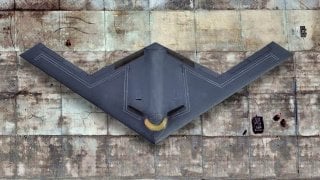The Air Force's B-21 Raider Bomber Nightmare Is a Math Problem
Despite plans to build approximately 133 B-21 Raider bombers, concerns arise about whether this number will suffice to maintain an edge over potential adversaries, especially given the anticipated larger fleets of China.
Summary: The B-21 Raider, developed by Northrop Grumman under the Long Range Strike Bomber program initiated in 2011, is set to replace older models like the B-52, B-1B, and B-2.
-Despite plans to build approximately 133 B-21 Raider bombers, concerns arise about whether this number will suffice to maintain an edge over potential adversaries, especially given the anticipated larger fleets of China.
-The Raider’s introduction is crucial as it enhances the U.S.'s capacity for intelligence, battle management, and deep-strike capabilities, ensuring its prominence in future aerial warfare
Is 133 Enough? The Debate Over the B-21 Raider's Fleet Size Amid Rising Adversaries
The U.S. Air Force continues to work on its next-generation stealth bomber. The B-21 Raider is designed to prevail against enemy air defenses and deliver weapons on targets deep inside hostile territories.
While the B-21 will elevate the service’s aerial capabilities, it may have company in the skies. China and Russia are working to produce their own next-generation counterparts, the H-20 and the PAK-DA, respectively. With geopolitical tensions rising, timely introduction of the Raider is a top U.S. priority.
However, it will not be easy to build a lot of these stealth bombers, and it will not be cheap. Some analysts argue that the Air Force’s planned 100-bomber fleet will not be enough to maintain a competitive edge over its adversaries.
Introducing the B-21 Raider
Unlike China and Russia, the U.S. already flies three solid strategic bombers: the B-52 Stratofortress, the B-1B Lancer and the B-2 Spirit. Each of these platforms would be useful in a great power war, but they would not provide the Air Force with the advantage it would need against the H-20 or perhaps even the PAK-DA.
The Long Range Strike Bomber program was created in 2011 to answer the Air Force’s call for a next-generation platform. The service wanted the bomber to function as an intelligence collection platform, battle platform, battle manager, and interceptor aircraft. Manufacturer Northrop Grumman was ultimately selected to build the bomber from the ground up.
While exact specs surrounding the Raider remain highly classified, some limited intel is available. The platform was officially unveiled in late 2022 at Northrop Grumman’s production facilities in Palmdale, California. The aircraft was smaller than its Spirit predecessor. Since a smaller frame is more difficult to detect, the Raider already boasts a significant improvement over previous bomber models.
Will 100 Raider Bombers Be Enough?
Even if the Raider as an aircraft has no match, China’s expected larger fleet of bombers could give Beijing the greater advantage in the skies. According to the director of future concepts at the Mitchell Institute for Aerospace Studies, Col. Mark Gunzinger, the Department of Defense currently plans to produce a Raider bomber fleet of around 133 aircraft by the early 2030s.

For reference, this is less than the 141 B-1, B-2, and B-52 bombers in service today, and that number is already low relative to the Air Force’s history.
If a war between Beijing and Washington erupts over the next decade, the size of the Air Force’s next-generation bomber fleet could be extremely important. Since the service is also working to produce future platforms like the Next Generation Air Dominance fighter, its budget is tight.
However, a long-range stealth bomber would play an important role in a great power war and is certainly well worth any cost.
About the Author: Maya Carlin
Maya Carlin, National Security Writer with The National Interest, is an analyst with the Center for Security Policy and a former Anna Sobol Levy Fellow at IDC Herzliya in Israel. She has by-lines in many publications, including The National Interest, Jerusalem Post, and Times of Israel. You can follow her on Twitter: @MayaCarlin.
All images are Creative Commons.


